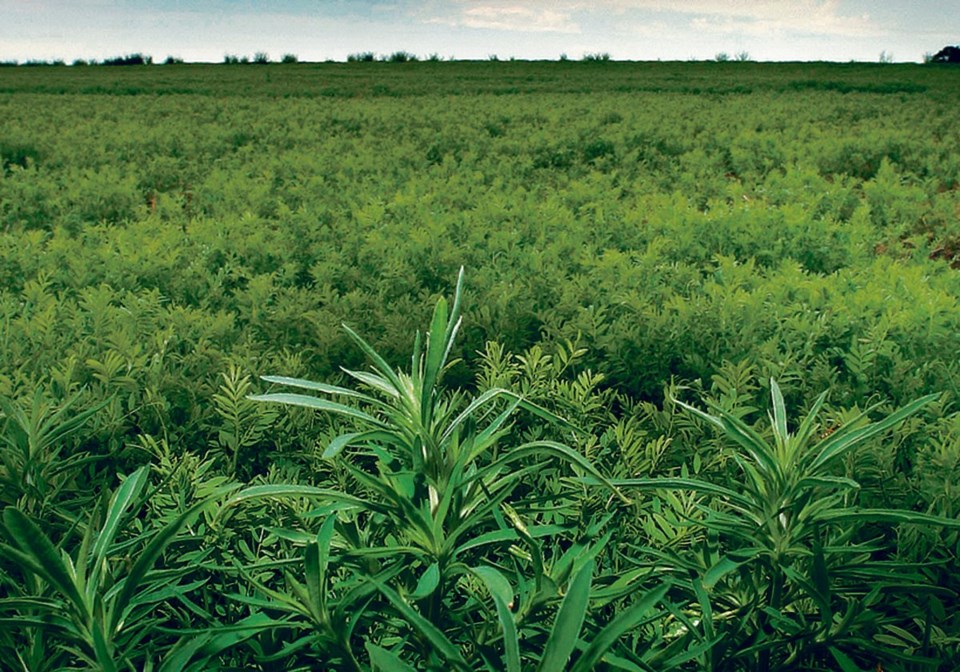WESTERN PRODUCER —- Every weed has a weakness.
For kochia, the pesky tumbleweed that’s become difficult to control in parts of Western Canada, that weakness is burial.
Research has shown the seeds of kochia are less likely to germinate when they’re buried in the soil.
For the last few years, Agriculture Canada scientists in Saskatoon have been studying methods to “artificially” bury kochia seeds in the soil as a possible way to control the tumbleweed.
The idea is founded on the principle that kochia typically appears in patches within a field rather than across the entire field.
“Only treat kochia where it is found,” said Shaun Sharpe, an Agriculture Canada weed scientist who spoke at the Saskatchewan Agronomy Research Update, held Dec. 10-11 in Saskatoon.
“The idea with patch management … (is) if we can pick out where it is and manage it heavily … we can apply a mulch or something to bury it.”
As Sharpe noted in his presentation, kochia has developed resistance to multiple herbicides and become a pernicious weed in parts of the Prairies.
In Canada, there are confirmed cases of kochia С����Ƶ resistant to Group 2, Group 9 (glyphosate), Group 4 and Group 14 herbicides.
Kochia’s resistance to herbicides is likely to get worse, so growers need alternative solutions to keep it in check.
Patches of kochia typically occur in areas near sloughs or in the marginal parts of the field.
“Wind is a major driver. Anywhere a tumbleweed can get caught…. You may have a path where a tumbleweed travelled and get growth (of kochia) there. But rarely do I see a whole field infestation.”
A combine can also spread kochia seeds as it moves across the field.
Sharpe’s idea of “burying” kochia seed comes from a study done around 2005. Rene Van Acker, a former University of Manitoba weed scientist who is now the vice-president of the University of Guelph, was part of a project that looked at kochia seeds and germination.
“In growth room studies, kochia seed placed at the soil surface had greater emergence compared with seed burial to a 10 millimetre or greater depth,” says the abstract for the study.
“Burying seed will greatly reduce future kochia populations.”
Previous studies have already established that tillage is an effective way to bury kochia seed and control the weed. However, Sharpe wanted to study other methods because “we don’t want to go backwards” on tilling cropland.
“We’re in an environment where we don’t want to use tillage (because of) soil conservation,” said Sharpe.
From 2021-23, Sharpe partnered with six farmers around Last Mountain Lake north of Regina for a real-world experiment.
At those six sites, Ag Canada scientists applied a layer of different materials to a patch of kochia, including:
- black plastic
- chaff
- hydro-mulch (a slurry of seeds, mulch and fibre that’s used in erosion control)
The researchers also mowed patches of kochia.
They did the experiment over three years and tracked the effectiveness of the different treatments.
The plastic mulch was the best, providing 100 per cent control.
However, spreading a layer of plastic on cropland isn’t a great idea.
The chaff was also effective. The level of control was 44 to 95 per cent with higher levels in the first year of the study.“The chaff treatment … we used whatever was in the field. We tried to get it six centimetres in depth,” Sharpe said.
“I’m very excited about this because chaff and straw is something that every farmer is going to have.”
Mowing was also effective — it controlled 50 95 per cent of the kochia population in the patch. However, it did require three to five cuttings per growing season.
The hydro-mulch was less effective.
Following his presentation, an audience member asked Sharpe about the risks associated with placing a layer of chaff on a patch of kochia. Wouldn’t that transport other weed seeds to the patch?
“Yes…. All the weeds in your field prior to harvest are coming out in the chaff,” he said.
“(But) if we’re going to seed a (weed) that’s not kochia, that’s OK with me too, just because you’re going to have additional competition in those patches.”
Sharpe’s research on “artificial” burial of kochia seeds is not yet published. He is now editing the paper and hopes to submit it for publication early in 2025.
About the author
Related Coverage




